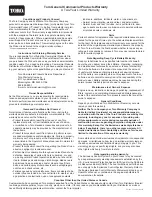
Maintenance
Check Safety Circuits
The electrical safety circuits of the lift require the vehicle
to be parked on a slope of less than 5 degrees, parking
brake to be engaged and the ignition key off in order
to activate the lift circuit.
To verify parking brake switch
operation:
1. Position the vehicle on a level surface, set parking
brake and chock wheels.
2. Rotate vehicle key switch to "Off" position. While
standing next to machine, grasp pendant control and
rotate lift key switch to "On" position. Press "UP"
button and raise lift a few inches. Release button.
3. Release parking brake and try to raise lift again. Lift
must not rise. If lift does not raise, safety circuit is
operating correctly and proceed to next step. If lift
rises there is a malfunction in the electrical circuit
that must be repaired before operating lift.
4. With the platform partially raised and parking brake
released, try to start engine. If engine does not
start and remain running, safety circuit is operating
correctly. Lower lift all the way and proceed to next
step. If engine starts and remains running there is
a malfunction in the electrical circuit that must be
repaired before operating lift.
To verify rear axle level switch
operation:
1. Position one side of vehicle (rear axle) on a slope
greater than 5 degrees (floor jack, mound of material
or small hill).
2. Set parking brake and chock wheels.
3. Rotate vehicle key switch to "Off" position. While
standing next to machine, grasp pendant control and
rotate lift key switch to "On" position. Press "UP"
button and try to raise lift. If lift does not raise,
safety circuit is operating correctly. Raise opposite
side of machine and repeat procedure. If lift rises,
with either side of machine in raised position, there
is a malfunction in the electrical circuit that must be
repaired before operating lift. Lower lift immediately.
Battery Care
1. Battery electrolyte level must be properly maintained
and the top of the battery kept clean. If the machine
is stored in a location where temperatures are
extremely high, the battery will run down more
rapidly than if the machine is stored in a location
where temperatures are cool.
2. Keep top of battery clean by washing periodically
with a brush dipped in ammonia or bicarbonate of
soda solution. Flush the top surface with water after
cleaning. Do not remove the fill cap while cleaning.
3. Battery cables must be tight on terminals to provide
good electrical contact.
4. If corrosion occurs at terminals, remove battery
cover, disconnect cables, negative (-) cable first and
scrape clamps and terminals separately. Reconnect
cables, positive (+) cable first and coat terminals
with petroleum jelly.
5. Check the electrolyte level every 50 operating hours
or, if machine is in storage, every 30 days.
6. Maintain cell level with distilled or demineralized
water. Do not fill cells above the bottom of the fill
ring inside each cell.
7. If the machine will be stored for more than 30
days, remove the battery and charge it fully. Either
store it on the shelf or on the machine. Leave the
cables disconnected if stored on the machine. Store
the battery in a cool atmosphere to avoid quick
deterioration of the charge in the battery. To prevent
battery from freezing, make sure it is fully charged.
The specific gravity of a fully charged battery is
1.250.
Battery electrolyte contains sulfuric acid which
is a deadly poison and it causes severe burns.
•
If you carelessly drink electrolyte you could
die or if it gets onto your skin you will be
burned.
•
Do not drink electrolyte and avoid contact
with skin, eyes or clothing.
•
Wear safety glasses to shield your eyes and
rubber gloves to protect your hands.
•
Fill the battery where clean water is always
available for flushing the skin.
•
Follow all instructions and comply with all
safety messages on the electrolyte container.
20





































